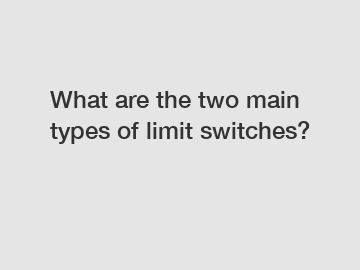What are the two main types of limit switches?
What are the two main types of limit switches?
The two main types of limit switches are mechanical and proximity limit switches.
Mechanical limit switches are the traditional type that use physical contacts and mechanical movement to detect the presence or absence of an object. They consist of a lever arm or plunger that makes or breaks contact with an electrical circuit when it comes into contact with an object. This mechanical movement triggers a response, such as turning on or off a motor or signaling an alarm.

On the other hand, proximity limit switches are non-contact switches that use an electromagnetic field to detect the presence or absence of an object. They rely on the principle of electromagnetic induction to sense the target object. These switches typically consist of a sensor and electronic circuitry that generate and detect the electromagnetic field. When an object enters the sensing range, it disturbs the field, and the sensor detects the change, triggering a response.
The distinction between mechanical and proximity limit switches lies in their detection methods. While mechanical switches require physical contact with an object to operate, proximity switches operate without physical contact, relying on electromagnetic fields instead. This difference in operation allows proximity switches to have several advantages over mechanical switches.
First, proximity limit switches have a longer lifespan as they do not suffer from mechanical wear and tear associated with physical contact. This makes them more reliable and suitable for applications where frequent switching is required.
Second, proximity limit switches are less prone to false triggering caused by vibration, dirt, or moisture. Since they do not rely on the physical movement of a lever arm or plunger, they are less affected by external factors that may accidentally activate the switch.
Third, proximity limit switches can detect objects regardless of their material, as long as they have a certain level of conductivity. This flexibility allows them to be used in various industries, such as manufacturing, automation, and robotics.
In conclusion, the two main types of limit switches are mechanical and proximity limit switches. While mechanical switches use physical contacts and mechanical movement, proximity switches rely on electromagnetic fields for object detection. Proximity switches offer advantages such as longer lifespan, immunity to false triggering, and versatility in detecting objects. Understanding the different types of limit switches and their capabilities is crucial in selecting the appropriate switch for specific applications.
If you are looking for more details, kindly visit What Triggers a Limit Switch?, Spring Lever Limit Switch, Whisker Limit Switch.


